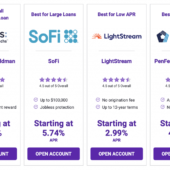by Rachel Christian, CEPF®
Senior Writer
Looking for a nearly risk-free way to save for the future? A savings bond might be right for you.
With amounts ranging from $25 to $10,000, U.S. savings bonds fit almost any budget. Most importantly: You’ll never lose value on your initial investment.
Plus these bonds are backed by the full faith and credit of the U.S. government — which has never defaulted on bonds.
The catch? Savings bonds typically don’t earn much interest. However, that’s not always the case, especially during times of high inflation.
Curious to learn how savings bonds work?
Read on.
A savings bond is essentially a loan to the federal government issued by the U.S. Treasury.
Think of it as an IOU from Uncle Sam. You give the government your money, and in exchange, the U.S. government pays you back — with interest — at a later date.
There are two types of savings bonds:
Savings bonds are sold at face value. If you want to invest $100, for example, you buy a $100 bond. There are no fees or hidden expenses.
After you purchase a bond, you start earning interest on your principal. Interest can accumulate for as long as 30 years.
Savings bonds are considered one of the safest investments out there. The interest rate can’t go below zero and the bond value can’t decline.
Savings bonds work by paying you compound interest on your deposit.
A savings bond accrues interest over time, though interest doesn’t pay out until you redeem the bond.
Interest on savings bonds is compounded semiannually, or twice a year.
This means that every six months after the bond’s issue date, interest the bond earned in the six previous months is added to the bond’s principal value. Interest is then earned on this new, higher principal value.
Here are some other characteristics of savings bonds:
The fastest and easiest way to buy savings bonds is from the U.S. Treasury’s online portfolio platform, TreasuryDirect.
To get started, you will need to make an account, enter some personal details and link your bank account information.
Electronic bonds purchased through TreasuryDirect are usually added to your online account in just one business day.
The U.S. Treasury also lets you purchase savings bonds via automatic payroll deductions.
To get started, log into your TreasuryDirect account and set up a Payroll Savings Plan. Decide what type of savings bond you want to purchase along with the dollar value.
Finally, give your employer these direct deposit instructions and ask them to send the amount you choose to TreasuryDirect each time you get paid.
Once your Payroll Savings Plan is up and running, the U.S. Treasury system will automatically purchase the type of bond you want each time you’ve accumulated enough money in your account.
For example, if you want to buy $50 Series I savings bonds and you ask your employer to withhold $25 from each paycheck, TreasuryDirect will purchase a $50 bond on your behalf every other payday.
These payroll deductions continue automatically until you update your preferences.
Once upon a time, you could buy paper savings bonds from your local bank or credit union. This hasn’t been the case since 2012.
However, you can still purchase paper I bonds with your federal tax refund when you file your annual tax return. (Paper EE bonds are no longer available.)
You can purchase up to $5,000 in paper I bonds each calendar year. Paper I bonds come in denominations of $50, $100, $200, $500 and $1,000.
Just tell your tax preparer you want to buy Series I savings bonds with part or all of your refund. If you use tax preparation software like TurboTax, the program will walk you through the process.
The Internal Revenue Service (IRS) will forward your savings bond request to the Treasury Department, and you should receive your paper bond at the address on your tax return in about three weeks.
The biggest difference between I bonds and EE bonds is how they earn interest.
Series I bonds rates are tied to inflation. As inflation goes up, so does the variable interest rate on these bonds.
I bond rates are derived from two different figures:
I bonds issued from November 2021 through April 2022 pay a composite annualized rate of 7.12% for six months.
On May 1, 2022, The Treasury will calculate a new inflation rate. If inflation continues to heat up, you could earn more interest. If it cools off, your variable rate declines.
Remember: Even if inflation goes down, you won’t lose any money. You just won’t earn as much interest as you did when inflation was higher.
EE savings bonds earn the same fixed interest rate for up to 30 years. It doesn’t change over time.
Regardless of the fixed interest rate, the bond will be worth twice what you paid for it after 20 years.
These bonds will continue earning interest at their original fixed rate for another 10 years unless new terms and conditions are announced before the final 10-year period begins.
Series EE savings bonds purchased from November 2021 through April 2022 earn an annual rate of 0.10%.
Series EE bonds replaced Series E bonds which were first issued to help the government fund itself during World War II. Series E bonds were sold until 1980 and are no longer issued.
Cashing in electronic savings bonds is quick and easy.
Simply log in to your account on TreasuryDirect and follow the redemption instructions.
Your initial investment plus any interest earned will be deposited into your linked checking or savings account within two business days.
Important facts to know about cashing in your bonds:
You can redeem the cash value of paper bonds on the TreasuryDirect website or at financial institutions.
If you redeem a paper bond at a bank or credit union, bring your ID with you along with the savings bond.
The financial institution will usually give you a tax form when you’re there, or it will mail one to you.
If a financial institution doesn’t accept your bond, check out these institutions from the Treasury website.
Savings bonds can be a great way to diversify your portfolio.
But they’re not the best investment in every situation.
You can earn a better return by putting your money in a high-yield savings account or investing in the stock market.
When inflation is high, Series I bonds are a great investment. They earn an attractive rate that compounds twice a year. You can start small and your investment is backed by the U.S. government.
But when inflation is lower, other investments have historically earned higher returns. The stock market, for example, has historically earned a 10% annual return.
Series EE bonds can be a good investment if you have a long time horizon and a very low risk tolerance. They can also be useful to pay for future college expenses.
You don’t pay federal taxes on accrued interest until you redeem the savings bond.
Savings bonds aren’t subject to state or local taxes either.
Savings bonds used to finance education won’t be subject to any taxes.
Yes. To give an electronic bond to someone else, both you and your recipient must create a TreasuryDirect account.
You will also need to know the recipient’s full name and Social Security number or taxpayer ID number.
To gift a paper I bond, you need to fill out an additional form when you file your federal tax return.
Rachel Christian is a Certified Educator in Personal Finance and a senior writer for The Penny Hoarder.
Ready to stop worrying about money?
Get the Penny Hoarder Daily
Privacy Policy
© 2022 The Penny Hoarder. – All rights reserved.
Privacy Policy and Terms of Service | Do Not Sell My Personal Information | Cookies Settings






